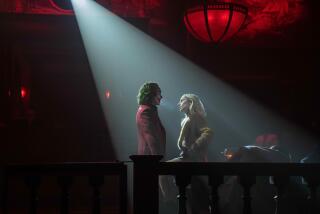‘The Roar and the Poor
Long the whipping boy of serious American culture, musicals nevertheless can be the most powerful form of theater. Anyone who doubts or has forgotten their potential for rapture need only see the opening number of Disney’s “The Lion King” on Broadway at the New Amsterdam Theatre. People will be talking about its particular fusion of music, story and spectacle for as long as anyone is alive to remember it.
As the animals created by Julie Taymor make their way down the theater aisles, creating an aura of mystery, they are pulled forward by ever-building rhythms that climax in the presentation of a newborn animal onstage. The song, “Circle of Life,” is about the munificence and the bounty of our emotions, just as the show is about the abundance of Taymor’s theatrical imagination. By trusting in that imagination, and through the added power of big money and big hype, Disney has managed to produce a fantastic act of theater.
But what of the musicals that get lost in the shadow of “The Lion King”? This is a busy year on Broadway, with a number of deep-pocket players making bids for immortality in the musical arena. They include songwriter Paul Simon, who has invested some of his own money into his musical “The Capeman,” which opens next month. A week after that, Broadway will finally welcome “Ragtime,” the first all-new musical produced by the Canadian impresario Garth Drabinsky, who, like Disney, has the tremendous financial luxury of owning a Broadway theater.
Accepted wisdom says the more shows, the better--that a crowded season is good for the entire industry. Good shows stimulate ticket sales all around. But “The Lion King” may just be the hit that shatters accepted wisdom, that dwarfs the shows around it. Insiders now guess the cost at close to $20 million, making “The Lion King” the most expensive musical ever produced. Other shows look ordinary next to it.
It’s difficult to care about the fate of “Triumph of Love,” a wan and unfunny adaptation of Marivaux at the Royale Theatre. “The Scarlet Pimpernel” may or may not find its escapist-fluff-loving audience at the Minskoff.
But there’s yet another musical whose life currently hangs in the balance, an oddity called “Side Show” at the Richard Rodgers. Rather like its unusual heroines, the Siamese twins Daisy and Violet Hilton, “Side Show” demands special attention. Now struggling at the box office to reach the $325,000 it costs to run the show each week, “Side Show” may not make it through the harsh winter months of the new year, when ticket sales traditionally dip. If “Side Show” gets trampled by “The Lion King” this January and closes, it would truly be a loss.
Next to “The Lion King,” “Side Show” appears far less opulent; specifically, its sets and its orchestrations look and sound almost shabby by comparison. But, aside from its financial disadvantage--it was financed at $5 million--”Side Show” suffers from a thematic disadvantage as well. “The Lion King” exhorts us to find the majesty of the natural world within ourselves; “Side Show” says we are all freaks of nature. “The Lion King” opens with a ceremonial parade of birth, stating, “It’s the circle of life/And it moves us all.” “Side Show” opens with an assortment of spaced-out circus people spread out on bleachers, imploring: “Come look at the freaks/Come gaze at the geeks/ . . . Come see God’s mistakes.”
While the message of “Side Show” lacks the obvious appeal of “The Lion King,” it exerts an emotional pull nevertheless. “Some hidden magnet is pulling me back/Back to this strange little show,” sings the character named Terry Connor (Jeff McCarthy), a producer who plucks the Hilton sisters out of the freak-show circuit and takes them to the relative splendor of vaudeville. Indeed, the show itself exerts a magnet, a weird siren song, thanks to some magic performed by director Robert Longbottom, making his Broadway debut, and the two wonderful actresses who play the sisters--Emily Skinner (Daisy) and Alice Ripley (Violet).
“Side Show” has music by Henry Krieger, who wrote the classic “Dreamgirls” score, and book and lyrics by Bill Russell. Indeed, “Side Show” offers the irresistible “Dreamgirls” formula--heart-rending music about ambition and the wish to find true love (Sony releases the original cast CD on Tuesday). Further, it uses the women’s malformation as a metaphor to explore issues of intimacy and of self-worth in a moving and original way.
Anyone who has seen the actual Hilton sisters in Tod Browning’s 1932 movie “Freaks” will have been touched by the central questions of how they experienced their lives. “Side Show” attempts to answer these questions, albeit using a sometimes-too-familiar show-biz vernacular. But if Russell’s book and lyrics can stumble awkwardly over cliches, they more often work cleanly and brilliantly to paint a portrait of two “normal” women who must go through life joined at the hip.
Using no Velcro or pins to hold them together, the women convey their conjoined state through simple but highly controlled choreography (also by Longbottom). The way their voices mingle when they sing, the angle at which they hold their heads to see each other or to be alone, creates an eerie, unusual bond. Watching them, you believe they occupy the same psychic space. There is something ineffably touching about their answer to Terry when he first meets them and asks them to describe their dreams. “I want to be like everyone else” sings Violet, and she goes on to describe a peaceful scene with a husband and a home. The physical impossibility of this overwhelms the straightforward, simple sentiment.
“Side Show” takes its fetching heroines even further into the ordinary disappointment and fears of the human heart. The sisters fall in love, and the two men they adore respond to them as well. But the task of marrying a Siamese twin proves to be too daunting for both men. First elated, then sensing the disappointment in store, the sisters sing a plaintive number in which they ask, “Who could proudly stand beside me/Who will love me as I am?”
In a sense, this coup de theatre is the opposite of the one accomplished in “The Lion King.” In front of you are two women standing close, their faces looking off in different directions, each one deep in an intensely personal emotion. If at this moment you are frozen in your seat, realizing that you connect with these twins more than you ever thought possible, you may also realize that this is extremely low-tech magic and is achieved only through believing these two women are who the creators say they are.
“Side Show” goes for emotions more intimate and thorny than anything running through the surface of “The Lion King” or “Ragtime” or any other musical so far this season. And yet it is an oddball show, a show that does have its flaws. People come away from it loving it or hating it. And both camps have to close their eyes at least somewhat to arrive at either conclusion.
Disney came to Broadway with its own theater and with a musical based on a wildly popular film, which grossed over $700 million worldwide before the musical ever opened on Broadway. “The Lion King” is like an impossibly privileged child among disadvantaged peers. One can only imagine the silence in offices all around Shubert Alley when “The Lion King” took in $2.7 million in one record-breaking day just after it opened. Indeed, in this climate, the title “Side Show” may become more ironic than even its creators intended.
* “The Lion King,” New Amsterdam Theatre, Broadway and 42nd Street, New York.
“Side Show,” Richard Rogers Theater, 226 W. 46th St., New York.
For tickets to both shows, call Ticketmaster: (800) 755-4000.
More to Read
The biggest entertainment stories
Get our big stories about Hollywood, film, television, music, arts, culture and more right in your inbox as soon as they publish.
You may occasionally receive promotional content from the Los Angeles Times.










